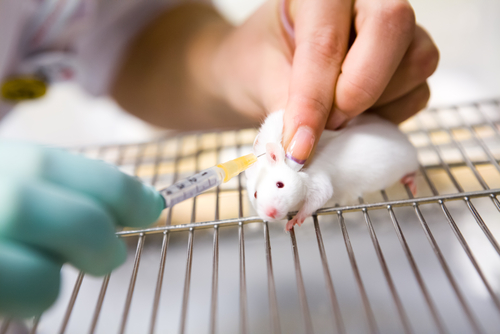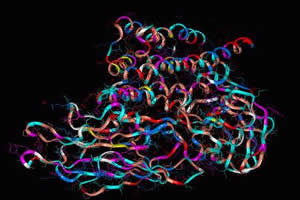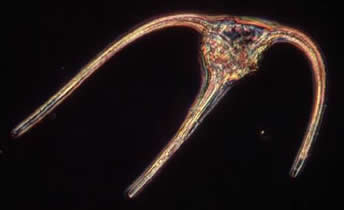Animais de Laboratório
Todos os animais que serão utilizados em laboratório são nascidos e criados em Biotério e o seu uso se restringe às experiências científicas.

Será que o uso de animais em experimentos científicos e pesquisas é realmente necessário?
A utilização de animais em laboratórios, tanto para fins médicos quanto para fins comerciais, é uma questão muito polêmica. Animais de várias espécies, sendo os camundongos mais intensamente utilizados, são empregados em experiências científicas e testes a fim de comprovar a eficiência de produtos como vacinas, cosméticos, medicamentos etc.
O uso de animais com objetivos científicos é uma prática comum que vem sendo empregada desde a Antiguidade, mas para que essa prática seja aceitável do ponto de vista ético e exponha resultados eficazes, é dever do especialista a consciência de que o animal que está sendo utilizado como cobaia é um ser vivo e como tal possui instinto, além de ser sensível à dor.
A questão sobre os direitos dos animais e sua utilização em experimentos científicos vem sendo discutida desde muitos anos, mas, em 1860, um fato ocorrido foi decisivo para o estabelecimento de limites no uso de animais como cobaias em experimentos de laboratório. O fisiologista francês Claude Bernard dizia que o uso de animais vivos era indispensável para experimentações e, por isso, ele mantinha um laboratório e um biotério nos porões de sua própria casa. Cansadas de ouvir os gritos de animais que diariamente eram torturados, a esposa e a filha de Claude o abandonaram e fundaram a primeira sociedade francesa em defesa dos animais. A partir dessa associação, diversas outras sociedades protetoras dos animais também foram fundadas, assim como leis específicas para esse tipo de uso dos animais.
A avaliação dos projetos de pesquisa em animais deve ter o mesmo rigor que a realizada em seres humanos, sendo que os animais utilizados nesses projetos científicos devem receber toda a atenção e cuidado. Em 1959, o zoologista William M.S. Russell e o microbiologista Rex L. Burch publicaram um livro em que estabeleceram os três R’s das pesquisas em animais: replace (substituir),reduce (reduzir) e refine (refinar). Para eles, a substituição de animais em experimentos científicos já avançou muito, podendo ser utilizado, no lugar de animais, culturas de células, simuladores e modelos matemáticos. Ainda segundo Russell e Burch, os experimentos devem ser mais bem planejados e as instalações adequadas, com pesquisadores capacitados para fazerem pesquisas em animais.
Como dissemos no início do presente artigo, esse é um assunto muito polêmico, que será alvo de vários questionamentos e discussões, tanto por parte dos protetores dos animais, quanto por parte de pesquisadores e cientistas. Mas, como sugeriu o filósofo Jeremy Bentham no ano de 1789, a questão não está ligada apenas ao fato de esses animais poderem raciocinar ou pensar e sim:Podem eles sofrer?
Por Paula Louredo
Graduada em Biologia
Fonte:
Laboratory Animals
All animals will be used in the laboratory are born and bred in animal facilities and their use is restricted to scientific experiments.
Does the use of animals in scientific experiments and research is really necessary?
The use of animals in laboratories, both for medical purposes and for commercial purposes, is a very contentious issue. Animals of various species, the mice more intensely used, are used in scientific experiments and tests in order to prove the efficiency of products such as vaccines, cosmetics, medicines etc..
The use of animals for scientific purposes is a common practice that has been used since ancient times, but that this practice is unacceptable from an ethical standpoint and expose effective results, it is the duty of the expert to realize that the animal is being used as a guinea pig is a living being and as such has instinct, besides being sensitive to pain.
The question of the rights of animals and their use in scientific experiments has been discussed for many years, but in 1860, a fact occurred was crucial for the establishment of limits on the use of animals as test subjects in laboratory experiments. The French physiologist Claude Bernard said that the use of live animals for experimentation was necessary and therefore he maintained a laboratory and vivarium in the basement of his own home. Tired of hearing the screams of animals being tortured every day, the wife and daughter of Claude abandoned and founded the first French company in defense of animals. From this association, several other animal protection societies were also founded, and laws specific to this type of animal use.
The evaluation of research projects on animals should have the same rigor that performed in humans, and the animals used in these scientific projects should receive full attention and care. In 1959, zoologist William MS Russell and microbiologist Rex L. Burch published a book that established the three R's of animal research: replace (replace), reduce (reduce) and refine (refine). For them, the replacement of animals in scientific experiments are quite advanced and can be used in place of animal cell cultures, simulators and mathematical models. Also according to Russell and Burch, the experiments should be better planned and the appropriate facilities with qualified researchers to do research on animals.
As we said at the beginning of this article, this is a very controversial subject, which will be the subject of many questions and discussions, both by the protectors of animals, as by researchers and scientists. But, as suggested by the philosopher Jeremy Bentham in 1789, the issue is not linked solely to the fact that these animals can reason or think but rather, Can they suffer?
By Paula Louredo
Graduated in Biology
Source: http://www.brasilescola.com/animais/animais-laboratorio.htm
Лабораторных животных
Все животные будут использоваться в лаборатории родился и вырос в животном средств и их использование ограничено научных экспериментов.
Ведет ли использование животных в научных экспериментах и исследованиях действительно необходимо?
Использование животных в лабораториях, как для медицинских целей, и в коммерческих целях, это очень спорный вопрос. Животных разных видов, мышей более интенсивно используются, используются в научных экспериментах и испытания, чтобы доказать эффективность продуктов, таких как вакцины, косметики, лекарств и т.д..
Использование животных в научных целях является обычной практикой, которые были использованы с древних времен, но, что эта практика является неприемлемым с этической точки зрения и подвергать эффективных результатов, это обязанность эксперта понимать, что животное в настоящее время используется в качестве подопытного кролика это живое существо и как таковой имеет инстинкт, помимо того, что чувствительность к боли.
Вопрос о правах животных и их использование в научных экспериментах обсуждается уже много лет, но в 1860 году, появился соответствующий факт имеет решающее значение для установления лимитов на использование животных в качестве испытуемых в лабораторных экспериментах. Французский физиолог Клод Бернар сказал, что использование живых животных для экспериментов было необходимо и, следовательно, он утверждал, лаборатории и террариумов в подвале его собственного дома. Устали слушать крики животными, которых мучают каждый день, жена и дочь Клода заброшен и основал первую французской компании в защиту животных. Из этого объединения, ряда других обществ защиты животных также были основаны, и законы, характерные для этого типа использования животных.
Оценка научно-исследовательских проектов на животных должны иметь те же строгостью, что выполняются на людях и животных, используемых в этих научных проектов, должны получать полное внимание и заботу. В 1959 году зоолог Уильям MS Рассел и микробиолог Rex L. Burch издал книгу, которая установила три важные вещи исследований на животных: заменить (заменить), снижение (уменьшение) и усовершенствовать (усовершенствовать). Для них, замена животных в научных экспериментах весьма продвинулись и может быть использован вместо животных культуры клеток, тренажеры и математических моделей. Также, по словам Рассела и Burch, эксперименты должны быть лучше плановых и соответствующие средства с квалифицированными исследователями для проведения исследований на животных.
Как мы уже говорили в начале этой статьи, это очень спорный вопрос, который будет предметом многих вопросов и обсуждений, как со стороны защитников животных, исследователи и ученые. Но, как полагает философ Иеремия Бентам в 1789 году, вопрос не связан исключительно с тем, что эти животные могут рассуждать или думать, но, скорее, могут ли они страдать?
Паула Louredo
Окончил в биологии
Источник: http://www.brasilescola.com/animais/animais-laboratorio.htm
Laboratory Animals
Alle Tiere werden im Labor verwendet werden, sind geboren und aufgewachsen in der Tier-Einrichtungen und deren Nutzung ist auf wissenschaftliche Experimente beschränkt.
Ist die Verwendung von Tieren in wissenschaftlichen Experimenten und Forschung ist wirklich notwendig?
Der Einsatz von Tieren in Labors, sowohl für medizinische Zwecke und für gewerbliche Zwecke, ist ein sehr umstrittenes Thema. Tiere verschiedener Arten werden die Mäuse stärker verwendet, in wissenschaftlichen Experimenten und Tests verwendet werden, um die Effizienz von Produkten wie Impfstoffen, Kosmetika, Arzneimitteln usw. nachzuweisen.
Der Einsatz von Tieren für wissenschaftliche Zwecke ist eine gängige Praxis, die seit der Antike verwendet wurde, sondern, dass diese Praxis nicht akzeptabel ist aus ethischer Sicht und setzen effektive Ergebnisse, ist es die Pflicht des Experten zu erkennen, dass das Tier verwendet wird wie ein Meerschweinchen ist ein Lebewesen und als solche Instinkt hat, abgesehen davon, empfindlich auf Schmerzen.
Die Frage der Rechte der Tiere und ihre Verwendung in wissenschaftlichen Experimenten ist seit vielen Jahren diskutiert, aber im Jahre 1860, war eine Tatsache eingetreten entscheidend für die Festlegung von Limiten auf die Verwendung von Tieren als Testpersonen in Laborversuchen. Der Physiologe Claude Bernard Französisch sagte, dass der Einsatz von lebenden Tieren für Experimente notwendig war, und deshalb behielt er ein Labor und Vivarium im Keller seines eigenen Hauses. Müde von hören die Schreie der Tiere gefoltert jeden Tag, gab die Frau und Tochter von Claude und gründete die erste Firma in Französisch Abwehr von Tieren. Aus dieser Vereinigung wurden mehrere andere Tierschutzorganisationen auch gegründet, sowie spezielle Gesetze für diese Art der Verwendung von Tieren.
Die Auswertung von Forschungsprojekten an Tieren sollten die gleiche Strenge, die bei Menschen durchgeführt, und die Tiere in diesen wissenschaftlichen Projekten verwendet werden, sollten volle Aufmerksamkeit und Pflege zu erhalten. Im Jahr 1959, Zoologe William MS Russell und Mikrobiologe Rex L. Burch veröffentlichte ein Buch, das die drei R von Tierversuchen festgelegt: ersetzen (replace), reduzieren (reduce) und Verfeinern (verfeinern). Für sie sind der Ersatz von Tieren in wissenschaftlichen Experimenten ganz vorgeschoben und kann anstelle von tierischen Zellkulturen, Simulatoren und mathematische Modelle verwendet werden. Auch nach Russell und Burch, sollten die Experimente besser geplant und die entsprechenden Einrichtungen mit qualifizierten Forscher Forschung an Tieren zu tun.
Wie wir am Anfang dieses Artikels sagte, ist dies ein sehr kontroverses Thema, das viele Fragen und Diskussionen, die beide von den Beschützer der Tiere zielen, wie Forscher und Wissenschaftler. Aber, wie der Philosoph Jeremy Bentham im Jahre 1789 vorgeschlagen, wird das Problem nicht allein auf der Tatsache, dass diese Tiere Grund oder denken, sondern können sie leiden verknüpft?
Von Paula Louredo
Studium der Biologie
Quelle: http://www.brasilescola.com/animais/animais-laboratorio.htm




